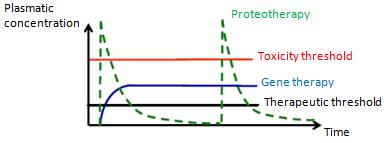Team:SupBiotech-Paris/Current therapies
From 2009.igem.org
Contents |
Current therapies
Current medicines [1]
Medicines are chemical or biological entities containing at least one active principle and act on a target tissue to treat it.
In the common language, a medicine is a substance delivered to correct, modify or restore a function in the organism.
In a chemical point of view, a medicine is a molecule that interacts with a molecular target. The binding modifies target properties, which give rise to a cell response. That is responsible for the benefits and side effects of a medicine.
Most current medicines target a protein. Proteins are necessary for organism survival and their dysfunction conduct to a lot of diseases. Nowadays, several proteins can be engineered to be used to treat a large number of diseases due to weak protein.
For cancer treatment, medicines act as inhibitors of mitosis. The toxicity selectivity of cytotoxic medicines is based on the higher mitosis activity of cancerous cells, which make them a preferential target. Selectivity is an important notion to evaluate a medicine. In fact, any medicine is really specific. Therefore, normal tissues with rapid renewal are also often damaged: epitheliums, bone marrow, and gonad.
It is essential to well-define a medicine. Among other properties, we have to study bioavaibility and resorption speed of a medicine. Bioavaibility may be incomplete due to different phenomenons as physico-chemistry characteristics or the intestine, hepatic or lung bypass.
The speed at which the drug is eliminated is also an important parameter for all administration routes without the intravenous route. The delay before the observation of the first (therapeutic or unwanted) effects of the drug also depends on this speed. Moreover, the existence of a biological rhythm is often neglected in the evaluation of their elimination. But, pharmacological medicine properties are closely linked to the phenomenon of temporality of the medicinal product. Several complementary and important concepts should be considered: systemic absorption speed and toxicity threshold.
Major problems facing these therapies are inter-patients variability in reactions to medications which become a substantial difficulty for the pharmaceutical research and medical considerations.
With the concern of improving the effectiveness of therapies, a new Pharmacology with genomic DNA or RNA for targets, has been developed: genetic pharmacology.
The genetic pharmacology interest [1,2]
The gene therapy challenge is to achieve correction of deficient cells (via genome modifications) which induce a disease. Unlike protein therapy, gene therapy is not only reducing symptoms but goes well below: it aims to the total deletion of the disease.
Even when an exogenous protein can be used, gene therapy has major advantages:
- Protein produced from the transgene is subjected to post-transcriptional host change processes. Glycosylation profile is therefore strictly like the patient’s one, it provides thus a better biocompatibility.
-It allows to pass the administration issue of complex proteins within the cell, in fact the transgene is expressed directly through the cell machinery.
-It allows local expression of the transgene, avoiding any risk linked to the systemic presence of protein.
Gene therapy has the advantage to present a better pharmacokinetic avoiding repeated administration of treatment and toxicity linked. It also allows a prolonged expression of the gene-medicine because the biological activity of transgenic protein appears to be greater than recombinant protein. In addition, deletion of injection peak helps to prevent a receptor desensitization.
Finally, a last point, which can seems less crucial but that certainly has its importance: the patients comfort. In fact, single administration (or repeated at very low frequency) is better tolerated by the patient as a day-to-day administration, as it is currently the case for insulin in the diabetes treatment. Moreover, the financial aspect is not negligible since the administration of chemical or biological drugs occurs in ambulatory or hospital and, thus, still slow down their generalization. Similarly, a recombinant protein extraction and purification cost is higher than the synthesis of an oligonucleotide.
Conclusion
Instability of proteins, their difficulties to be produced, are responsible for a large number of diseases. It thus highlights the interest of the drug-gene.
Few treatments have actually proved their effectiveness, without making a high toxicity. For this reason, gene therapy appears to be a very promising approach. Transforming the gene into a drug appears as a seductive strategy.
 "
"





